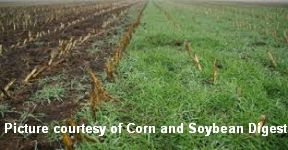AGRONOMIC RESOURCESTO SUPPORT EVERY SEASON
YOU CAN TAKETO THE FIELD
Importance of Fall Seeded Cover Crops
As another harvest season is upon us, there are a lot of decisions weighing on farmers minds. A couple of those would be fall fertilizer, as well as fall tillage. As I make my travels around SE Iowa over the past few years I have noticed a trend of some growers skipping the tillage practices and electing to go with cover crops instead. As this practice continues to catch on many questions arise from growers inquiring about trying cover crops. Most of these questions stem around why. Why should I seed cover crops, and what benefit will I get out of it? Fall seeded cover crops can bring many benefits to your farm.
When cover crops first started in this area it was primarily to stop or slow down soil erosion on the steeper hillsides. Cover crops have been and will continue to be a great tool for erosion control. The issue we had with this is that in most cases oats were the crop selected for the cover crop. While oats are a great cover because they grow very aggressively in the fall they do not over winter. Therefore, you are only protecting yourself against soil erosion in the fall. We receive much more annual rainfall in the spring so having a cover crop that would over winter became very important. Cereal rye is the most common cover crop being used in this area because it is easy to find and over winters very well. There are a whole host of other viable over wintering cover crop options as well.
 As the cover crops evolved we began to realize that they can be used on more acres than just very steep farms. This brings me to what I believe to be the biggest reason to plant cover crops - nutrient holding capabilities of the cover crop. For growers who are applying any kind of fall fertilizer, cover crops would be a great companion
As the cover crops evolved we began to realize that they can be used on more acres than just very steep farms. This brings me to what I believe to be the biggest reason to plant cover crops - nutrient holding capabilities of the cover crop. For growers who are applying any kind of fall fertilizer, cover crops would be a great companion  to that. What better way to hold your fall-applied anhydrous or fall-applied manure than to have it held in a plant that is rooted to your soil! Often cover crops are referred to as scavenger plants. Even if you aren’t doing any kind of fall fertilizer, your fall-seeded cover crops will scavenge any unused nutrients in your soil so that they do not leech out or volatilize. When these cover crops are terminated in the spring of the year they begin to breakdown. That process of breaking down the carbon in the cover crops releases any held nutrients back to your soil and back to your crops.
to that. What better way to hold your fall-applied anhydrous or fall-applied manure than to have it held in a plant that is rooted to your soil! Often cover crops are referred to as scavenger plants. Even if you aren’t doing any kind of fall fertilizer, your fall-seeded cover crops will scavenge any unused nutrients in your soil so that they do not leech out or volatilize. When these cover crops are terminated in the spring of the year they begin to breakdown. That process of breaking down the carbon in the cover crops releases any held nutrients back to your soil and back to your crops.
As you get into more diverse cover crops you can see more benefits such as breaking up soil compaction and plow layers with deeply rooted species of plants. These species of cover crops tend to be a little more expensive to seed and must be seeded a little earlier in the growing season. This makes them a great option for acres that are chopped for corn silage.
For more information, contact your LG Seeds Technical Team Agronomist.
Note: The information in this issue is based upon field observations and third-party information. Since variations in local conditions may affect the information and suggestions contained in this issue, LG Seeds disclaims legal responsibility therefore. Always read and follow label instructions.
Advantage Acre, LG Seeds and design are trademarks of AgReliant Genetics, LLC.
Download a copy of this Technical Bulletin: Tech_398 - Importance of fall seeded cover crops






Technical Team Agronomist